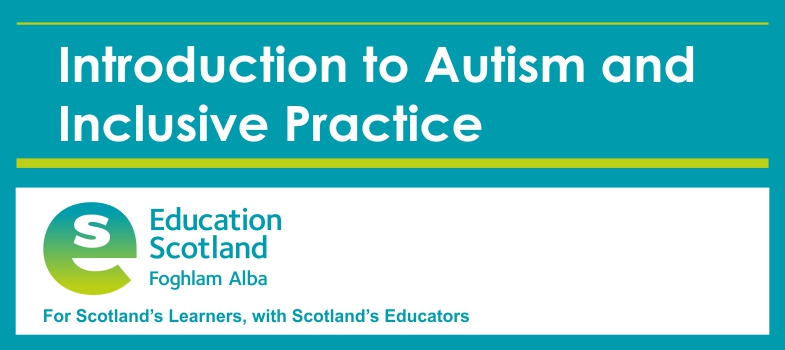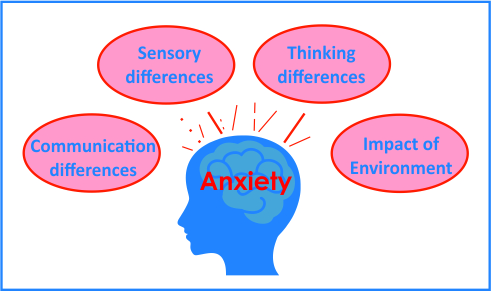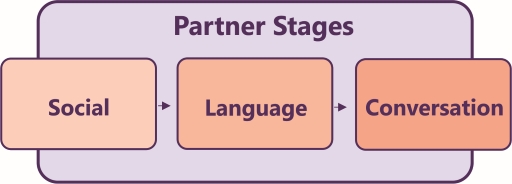3.8 Autism and anxiety
Everyone experiences anxiety at points in their life, usually in response to difficult or stressful situations. When such situations pass, anxiety usually reduces over time. Anxiety becomes problematic when it impacts on everyday life and gets in the way of the person’s everyday functioning, seems disproportionate to the situation or continues for a long time.
When the above four aspects illustrated in Figure 11 are not supported appropriately, this will lead to increased anxiety for the autistic person.
Prior to the unprecedented Covid-19 pandemic, we knew that people with autism experience anxiety more than the general population. In 2017, a review [Tip: hold Ctrl and click a link to open it in a new tab. (Hide tip)] of a number of studies found that children with autism spectrum disorder had higher anxiety levels than typically developing peers: this difference increased with cognitive ability.
The Covid-19 pandemic will have increased anxiety levels across the population and will, for some autistic learners, be a confusing and negative experience.
It becomes clear why autistic learners might experience anxiety when we take account of what autism is. Autistic individuals have:
- communication and social interaction difficulties
- sensory processing differences
- difficulties with social imagination and flexible thinking.
There are many reasons why autistic learners might experience higher levels of anxiety than their peers.
- Ours is a confusing and unpredictable world.
- Autistic learners’ daily experience may be confusing and unpredictable. Dealing with a series of unpredictable events or disrupted expectations can result in increased stress and anxiety.
- Understanding people and social situations (social awareness).
- Some learners may experience daily events and reactions of people as arbitrary and unexpected, meaning that life is likely to be experienced as random and scary.
- Some learners who may be more socially aware might have the knowledge that they do not understand people the way that other children do, and they may realistically predict that they will make mistakes in interpreting emotions, situations or social rules and expectations. They might also be aware that they do not have effective strategies to manage when they experience the feeling of always ‘getting it wrong’.
- Patterns of thinking – autistic learners can have thinking styles which focus on details rather than the bigger picture (weak central coherence). This thinking style may be linked to heightened experiences of anxiety. It is possible that those with a narrow focus in thinking may focus only on the detail of the ‘threat’ or ‘worry’ and fail to see the elements of the ‘big picture’ that might be reassuring.
Anxiety can manifest itself in a variety of observable behaviours, as well as internal experiences that will vary by developmental stage.
Some learners with more advanced language and social awareness may be able to express how they are feeling with words. Other children and young people with limited language, or even with advanced language, express their anxiety through behaviours. These behaviours should be interpreted as a sign of distress rather than thought of as ‘challenging’.
Common signs of anxiety
Some common signs of anxiety and distress might include noticeable:
- physiological signs (e.g. pale, sweating, trembling, restlessness)
- communication changes (e.g. increased or decreased chatting)
- reports of physical symptoms (e.g. stomach ache, headache, nausea or muscle pain).
Autistic learners experiencing anxiety may have difficulty sleeping and concentrating and may have a sense of losing control or have repetitive thoughts about perceived threat. They may feel worry, irritability or distress.
Those around the learner may not pick up the signs that they are anxious until they see the more obvious signs listed in the stages below. The behaviours have been grouped broadly by the three developmental stages within Figure 12.
Activity 11
Click and reveal on titles and descriptors
Social partner stage – Children and young people who do not yet use meaningful words who may communicate through actions and behaviour may show anxiety in the following ways:
Answer
- crying or screaming
- hitting out or kicking
- self-harming such as hitting head off objects
- withdrawing or refusal to take part
- an increase in repetitive movements, play sequences or phrases
- tantrums
- flight (running away)
- increased rigidity of routines/topic.
Language partner stage – Children and young people using simple language and short sentences to communicate may show anxiety in the following ways:
Answer
- hitting out or kicking
- flight
- withdrawal
- tantrums
- directing/trying to control the behaviour of or interactions with peers to make play predictable
- refusing
- arguing
- attempt to control the order of what is happening
- repetitive questions
- increased rigidity of routines/topic.
Conversation partner stage – Children and young people using complex language in a conversational way may show anxiety in the following ways:
Answer
- school refusal
- avoidance of unpredictable situations or those requiring social interaction
- flight
- hitting out or kicking
- hurting themselves
- seeking reassurance (possibly in an idiosyncratic way)
- concern about how they appear to others
- refusal
- arguing
- regression to previous habits e.g. repetitive questions or phrases that they no longer normally use
- increased rigidity of routines/topic.
The behaviours listed above may look different in a younger or older child (e.g. a 4-year-old hitting out is very different to a 15-year-old hitting out), but the behaviour may serve the same communicative purpose. It is important to note that there is no such thing as an autistic behaviour and these are ways anyone can express anxiety.
Anxiety build-up
As anxiety increases, a learner is less able to connect to their coping strategies or to their problem-solving skills and is therefore likely to become more inflexible than their normal presentation. An anxious autistic learner might well be avoidant and may appear oppositional when invited to try new experiences; refusing these experiences might be perceived as keeping themselves safe and less vulnerable than venturing into the unknown.
Supporting autistic learners with social anxiety
You will need to download this file.
Download an overview of ‘Supporting learners with Social Anxiety’.
Activity 12 Reflective Log
In your Reflective Log, consider the following questions.
- What is your setting doing to support autistic learners who experience anxiety and help reduce it?
- What further improvements could be made?
3.7 Supporting autistic learners in an educational setting


